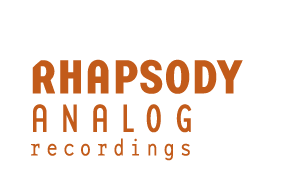Rhapsody Analog Recordings
Rhapsody Analog Recordings is proud to present the release of a new series of pure analog direct-to-2track recordings and offers direct copies from the mastertape on 1/4 inch analog tape, limited edition vinyl and in DXD/DSD format. These unique live recordings are sometimes done completely analog without the use of any digital equipment.
Rhapsody Analog Recordings is an initiative of Harry van Dalen and Michael van Polen of Rhapsody in collaboration with recording engineer Frans de Rond.
For more than 35 years Rhapsody operates at the ultimate level of high-end residential audio reproduction systems. During that period, Harry and Michael were involved in many music recording projects. All these years, their strong confidence in analog sound has never faded, on the contrary: they always felt that some of the magic and realism of an analog recording gets almost always lost when the recording is done digitally. Furthermore, they believe that due to new technical developments and innovation the quality of analog sound has undeniably improved.
To realize their own analog recordings Harry and Michael asked recording engineer Frans de Rond to partake in this project. Frans has been a professional recording engineer for many years and is specialized in recording acoustic music etc. This made him the most sought after engineer for radio plays in the Netherlands. With the three of us we are able to create an almost visible sound field and an organic, natural sound. As from today, together they are presenting their own direct-to-2track analog audiophile music recordings.
ATR Magnetics
ATR Magnetics analog tape from Pennsylvania, USA. explains the advantage of analog tape recording over digital.
Why Analog?
Analog sound is still relevant. It is not the old fashioned way of recording or reproducing audio: it is the other way next to digital.
As opposed to digital, analog sound is not fragmented and therefore has a natural continuity and flow.
Modern analog recording and playback equipment and tape also make it possible to capture and play analog audio better than ever before.
How Analog?
The recordings are as analog as it gets, that is: totally. There are no digital components in the recording chain. Microphones, cables, mixing board and recorder are all analog and should editing be necessary, it will be done by means of real cut and past technique.
Recording live in studio, direct-to-2track arguably is the purest, most direct way of recording, especially when it is done totally analog.In the last decade the quality of microphones, cables and tape has improved tremendously. Compared to the recent past, Harry, Michael and Frans think the audio quality of a modern analog recording chain is shockingly good. In addition, the lifespan of today’s analog tape has improved considerably as well.
” Quarter inch, two track ATR Master Tape running at 15 inches per second (ips) involves approximately 80,000,000 oriented and randomly stacked particles per track second. ”
Nothing Sounds Like Analog
To understand why a professional tape recorder provides the most lifelike reproduction revolves around a couple of important factors. The key lies in the inherent technology of the tape itself. Audio tape in use during the 1950s and ’60s provided approximately 65,000,000 magnetic particles per second of recording a quarter inch format at 15 inches per second (ips) tape speed. Each magnetic oxide particle or groups of particles takes on either a north or south orientation after exiting the recording head.
Starting to sound like digital bit stream? Well yes and no. However there is one huge difference between analog tape recordings and even the best digital recordings.
Random Particle Stacking
Quarter inch, two track ATR Master Tape running at 15 inches per second (ips) involves approximately 80,000,000 oriented and randomly stacked particles per track second. It’s not just the particle count but the random stacking that turns this super binary resolution into pure analog playback. This is why even a narrow track width recording still sounds so detailed despite the lower surface area
Resolutie
The highest digital resolution today offers 4,608,000 bits switching per second. Not bad. Big improvement over the standard Red Book CD but it is not even close to sub-micron particle resolution of ATR Master Tape.
Music is an intrinsic part of the human soul. It plays to our emotions, it talks to us, it calms us, it makes us rise to our greatest accomplishments and brings back our warmest memories. Why not record it on the best medium to achieve the best quality of sound?
